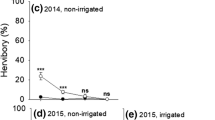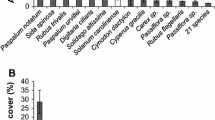Abstract
Although the concept that some plants benefit from being eaten is counterintuitive, there is now considerable evidence demonstrating enhanced fitness following herbivory. It has been assumed that plants growing in high resource conditions are the ones best able to compensate for herbivory. However, just the opposite has been found for dicotyledonous plants exhibiting patterns of overcompensation, with most occurring in resource-poor conditions. Long-term studies of the monocarpic biennial, scarlet gilia, Ipomopsis aggregata growing in resource-poor conditions have shown that ungulate herbivory by mule deer and elk can result in a threefold increase in plant fitness over uneaten controls. These observations led us to hypothesize that fungal associations would facilitate the compensatory response most commonly observed in this Arizona population of scarlet gilia; perhaps mutualistic associations with fungi, such as arbuscular mycorrhizal fungi, would explain the phenomenon of overcompensation altogether. Fungal removal experiments, using Captan®, a commercially available fungicide, showed that a reduction in fungal abundance altered the compensatory response following ungulate herbivory, particularly in years in which water was limited, increasing fitness compensation from equal compensation to overcompensation. A multifactorial experiment revealed that the interactive effects of water and fungicide maximized fruit production following herbivory. Our results are counter to the “modification of tolerance hypothesis” in which plants associating with mycorrhizal fungi will have higher tolerance to herbivory. It is likely that arbuscular mycorrhizal fungi and dark septate endophytes compete with plants for photosynthates following herbivory, thereby limiting the magnitude of compensation. Thus, fungi appear to be parasitic on scarlet gilia following ungulate herbivory.



Similar content being viewed by others
References
Alward RD, Joern A (1993) Plasticity and overcompensation in grass responses to herbivory. Oecologia 95:358–364. doi:10.1007/BF00320989
Anderson L, Paige KN (2003) Multiple herbivores and coevolutionary interactions in an Ipomopsis hybrid swarm. Evol Ecol 17:139–156. doi:10.1023/A:1023066101074
Bennett AE, Bever JD (2007) Mycorrhizal species differentially alter plant growth and response to herbivory. Ecology 88:210–218. doi:10.1890/0012-9658
Bennett AE, Alers-Garcia J, Bever JD (2006) Three-way interactions among mutualistic mycorrhizal fungi, plant enemies: hypotheses and synthesis. Am Nat 167:141–152. doi:10.1086/499379
Bolker BM, Brooks ME, Clark CJ, Geange SW, Poulsen JR, Stevens MHH, White J-SS (2008) Generalized linear models: a practical guide for ecology and evolution. Trends Ecol Evol 24:127–135. doi:10.1016/j.tree.2008.10.008
Borowicz VA (1997) A fungal root symbiont modifies plant resistant to an insect herbivore. Oecologia 112:534–542. doi:10.1007/s004420050342
Borowicz VA (2001) Do arbuscular mycorrhizal fungi alter plant-pathogen relations? Ecol 82:3057–3068. doi:10.1890/0012-9658(2001)082[3057:DAMFAP]2.0.CO;2
Brundett M, Bougher N, Dell B, Grove T, Malajczuk N (1996) Working with mycorrhizas in forestry and agriculture. Australian Centre for International Agriculture Research, Canberra
Bryant JP, Chapin FS III, Klein DR (1983) Carbon/nutrient balance of boreal plants in relation to vertebrate herbivory. Oikos 40:357–368. doi:10.2307/3544308
Coley PD, Bryant JP, Chapin FS III (1985) Resource availability and plant anti-herbivore defense. Science 230:895–899. doi:10.1126/science.230.4728.895
DeMars B, Boerner R (1995) Mycorrhizal status of Deschampsia antarticas in Palmer Station area, Antartica. Mycologia 87:451–453. doi:10.2307/3760760
Gange AC, Ayres RL (1999) On the relation between arbuscular mycorrhizal colonization and plant ‘benefit’. Oikos 87:615–621. doi: 10.2307/3546829
Gange AC, Brown VK (2002) Soil food web components affect plant community structure during early succession. Ecol Res 17:217–227. doi: 10.1046/j.1440-1703.2002.00481.x
Gange AC, West HM (1994) Interactions between arbuscular mycorrhizal fungi and foliar-feeding insects in Plantago lanceolata L. New Phytologist 128:79–87. doi: 10.1111/j.1469-8137.1994.tb03989.x
Gardner R (1975) An overview of botanical clearing techniques. Stain Technol 50:99–105. doi:10.3109/10520297509117042
Garrido E, Bennett AE, Fornoni J, Strauss SY (2010) Variation in arbuscular mycorrhizal fungi colonization modifies the expression of tolerance to above-ground defoliation. J Ecol 98:43–49. doi:10.1111/j.1365-2745.2009.01586.x
Gaur A, Adholeya A (2005) Diverse response of five ornamental plant species to mixed indigenous and single isolate arbuscular-mycorrhizal inocula in marginal soil amended with organic matter. J Plant Nutr 28:707–723. doi:10.1081/PLN-200052647
Gehring CA, Cobb NS, Whitham TG (1997) Three-way interactions among ectomycorrhizal mutualists, scale insects, and resistant and susceptible pinyon pines. Am Nat 149:824–841. doi: 10.1086/286026
Gehring CA, Whitham TG (2002) Mycorrhizae–herbivore interactions: population and community consequences. In: van der Heijden MGA, Sanders I (eds) Mycorrhizal ecology. Ecological studies vol. 157. Springer, Berlin, pp 295–320
Giovannetti M, Mosse B (1980) An evaluation of techniques for measuring vesicular arbuscular mycorrhizal infection in roots. New Phytol 84:489–500. doi:10.1111/j.1469-8137.1980.tb04556.x
Hawkes CV, Sullivan JJ (2001) The impact of herbivory on plants in different resource conditions: a meta-analysis. Ecology 82:2045–2058. doi:10.1890/0012-9658
Hereford R (2007) Climate history of Flagstaff, Arizona—1950 to 2007. Floods, droughts, and long-term warming. U.S. Geological Survey, Flagstaff
Hoeksema J, Chaundhary V, Gehring C, Johnson N, Karst J, Koide R, Pringle A, Zabinski C, Bever J, Moore J, Wilson G, Klironomos J, Umbanhowar J (2010) A meta-analysis of context-dependency in plant response to inoculation with mycorrhizal fungi. Ecol Lett 13:394–407. doi:10.1111/j.1461-0248.2009.01430.x
Jakobsen I, Smith SE, Smith FA (2002) Function and diversity of arbuscular mycorrhizae in carbon and mineral nutrition. In: van der Heijden MGA, Sanders IR (eds) Mycorrhizal ecology. Ecological studies vol. 157. Springer, Berlin, pp 75–92
Johnson N, Graham J, Smith F (1997) Functioning of mycorrhizal association along the mutualism-parasitism continuum. New Phytol 135:575–585. doi:10.1046/j.1469-8137.1997.00729.x
Jones MD, Smith SE (2004) Exploring functional definitions of mycorrhizas: Are mycorrhizas always mutualisms? Can J Bot 82:1089–1109. doi:10.1139/b04-110
Juenger T, Bergelson J (1998) Pairwise and diffuse natural selection and the multiple herbivores of scarlet gilia, Ipomopsis aggregata. Evolution 52:1583–1592. doi:10.2307/2411332
Juenger T, Bergelson J (2000)The evolution of compensation to herbivory in scelat gilia, Ipomopsis aggregata: herbivore-imposed natural selection and the quantitative genetics of tolerance. Evol 19:79–101. doi:10.1111/j.0014-3820.2000.tb00078.x
Jumpponen A (2001) Dark septate endophytes—are they mycorrhizal? Mycorrhiza 11:207–211. doi:10.1007/s005720100112
Klironomo JN (2003) Variation in plant response to native and exotic arbuscular mycorrhizal fungi. Ecology 84:2292–2301. doi:10.1890/02-0413
Kough J, Gianinazzi-Pearson V, Gianinazzi S (1987) Depressed metabolic activity of vesicular-arbuscular mycorrhizal fungi after fungicide applications. New Phytol 106:707–715. doi:10.1111/j.1469-8137
Latijnhouwers M, de Wit PJGM, Govers F (2003) Oomycetes and fungi: similar weaponry to attack plants. Trends Microbiol 11:462–469. doi:10.1016/j.tim.2003.08.002
Lennartsson TG, Tuomi J, Nilsson P (1997) Evidence for evolutionary history of overcompensation in the grassland biennial Gentianella campestris (Gentianaceae). Am Nat 149:1147–1155. doi:10.1086/286043
Levine M, Paige KN (2004) Direct and indirect effects of drought on compensation following herbivory in scarlet gilia. Ecology 85:3185–3191. doi:10.1890/030748
Lowenberg GJ (1994) Effects of floral herbivory on maternal reproduction in Sanicula arctopoides (Apiaceae). Ecology 75:359–369. doi:10.2307/1939540
Mandyam K, Jumpponen A (2005) Seeking the elusive function of the root-colonising dark septate endophytic fungi. Stud Mycol 53:173–189. doi:10.3114/sim.53.1.173
Maschinski J, Whitham T (1989) The continuum of plant responses to herbivory: the influence of plant association, nutrient availability, and timing. Am Nat 134:1–19. doi:10.1086/284962
Mauricio R, Rausher MD, Burdick DS (1997) Variation in the defense strategies of plants: are resistance and tolerance mutually exclusive. Ecology 78:1301–1311. doi:10.1890/0012-9658
McGonigle T, Miller M, Evans D, Fairchild G, Swan J (1990) A new method which gives an objective measure of colonization of roots by vesicular-arbuscular mycorrhizal fungi. New Phytol 115:495–501. doi:10.1111/j.1469-8137.1990.tb00476.x
Murray TR, Frank DA, Gehring CA (2010) Ungulate and topographic control of arbuscular mycorrhizal spore community composition in a temperate grassland. Ecology 91:815–827. doi:10.1890/09-0209.1
Newsham KK (2011) A meta-analysis of plant responses to dark septate root endophytes. New Phytol 190:783–793. doi:10.1111/j.1469-8137.2010.03611.x
Nilsson P, Tuomi J, Astrom M (1996) Even repeated grazing may select for overcompensation. Ecology 77:1942–1946. doi:10.2307/2265796
NOAA (National Oceanic and Atmospheric Administration) (2008) Climate of 2007—in historical perspective. National Climatic Data Center, Asheville
Paige KN (1992a) Overcompensation in response to mammalian herbivory: from mutualistic to antagonistic interactions. Ecology 73:2076–2085. doi:10.2307/1941456
Paige KN (1992b) The effects of fire on scarlet gilia: an alternative selection pressure to herbivory? Oecologia 92:229–235. doi:10.1007/BF00317369
Paige KN (1994) Herbivory and Ipomopsis aggregata: a difference in response differences in experimental protocol, a reply to Bergelson and Crawley. American Nat 143:739–749. http://www.jstor.org/stable/2462910
Paige KN (1999) Regrowth following ungulate herbivory in Ipomopsis aggregata: geographic evidence for overcompensation. Oecologia 118:316–323. doi:10.1007/s004420050732
Paige KN, Whitham TG (1985) Individual and population shifts in flower color by scarlet gilia: a mechanism for pollinator tracking. Science 227:315–317. doi:10.1126/science.227.4684.315
Paige KN, Whitham TG (1987) Overcompensation in response to mammalian herbivory: the advantage of being eaten. Am Nat 129:407–416. doi:10.1086/284645
R Development Core Team (2013) R: A language environment for statistical computing. R Foundation for Statistical Computing, Vienna. Available at: http://www.R-project.org
Rautio P, Huhta AP, Pippo S, Tuomi J, Juenger T, Saari M, Aspi J (2005) Overcompensation and adaptive plasticity of apical dominance in Erysimum strictum (Brassicaceae) in response to simulated browsing and resource availability. Oikos 111:79–91. doi:10.1111/j.0030-1299.2005.14045.x
Scholes DR, Paige KN (2011) Chromosomal plasticity: mitigating the impacts of herbivory. Ecology 92:1691–1698. doi:10.1890/10-2269.1
Scholes DR, Paige KN (2014) Plasticity in ploidy underlies plant fitness compensation to herbivore damage. Mol Ecol 23:4862–4870. doi:10.1111/mec.12894
Scholes DR, Siddappaji M, Paige KN (2013) The genetic basis of overcompensation in plants: a synthesis. Int J Modern Bot 3:34–42. doi:10.5923/s.ijmb.201310.05
Siddappaji M, Scholes DR, Bohn M, Paige KN (2013) Overcompensation in response to herbivory in Arabidopsis thaliana: the role of glucose-6-phosphate dehydrogenase and the oxidative pentose-phosphate pathway. Genetics 195:589–598. doi:10.1534/genetics.113.154351
Sikes BA, Cottenie K, Klironomos JN (2009) Plant and fungal identity determines pathogen protection of plant roots by arbuscular mycorrhizas. J Ecol 97:1274–1280. doi:10.1111/j.1365-2745.2009.01557.x
Smith SE, Read DJ (2008) Mycorrhizal Symbiosis, 3rd edn. Academic Press, London
Strauss SY, Agrawal AA (1999) The ecology and evolution of plant tolerance to herbivory. Trends Ecol Evol 14:179–185. doi:10.1016/S0169-5347(98)01576-6
Watson AG (1965) Toxicity and persistence of certain fungicides against Plasmodiophora brassicae Wor. N Z J Agric Res 8:977–987. doi:10.1080/00288233.1965.10423732
Weinig C, Stinchcombe JR, Schmitt J (2003) Evolutionary genetics of resistance and tolerance to natural herbivory in Arabidopsis thaliana. Evolution 57:1270–1280. doi:10.1111/j.0014-3820.2003.tb00335.x
Wise MJ, Abrahamson WG (2007) Effects of resource availability on tolerance of herbivory: a review and assessment of three opposing models. Am Nat 169:443–454. doi:10.1086/591691
Acknowledgments
We thank Drs. Carol Augspurger, Andrew Miller, Victoria Borowicz, Sara Paver, Katie Amato, Emily Wheeler-Lankau, Arianne Peralta, and Greg Spyreas for comments on the manuscript. A special thanks to Dr. Rick Lankau for statistical guidance along with detailed comments on the manuscript. Funding was provided by summer research fellowships awarded to C. M. Allsup through the Program for Ecology, Evolution, and Conservation Biology at the University of Illinois and NSF Grants 0092554 and 1146085 to K.N. Paige. In addition we wish to thank Brett Olds, Eric Scott, Denise Paige, Kelly Allsup, and Karlton Allsup for their help in the field.
Author contributions statement
CMA and KNP conceived and designed the experiments. CMA and KNP conducted the field work. CMA collected and analyzed the data. CMA and KNP wrote the manuscript.
Author information
Authors and Affiliations
Corresponding author
Additional information
Communicated by Joel Sachs.
Electronic supplementary material
Below is the link to the electronic supplementary material.
Rights and permissions
About this article
Cite this article
Allsup, C.M., Paige, K.N. Belowground fungal associations and water interact to influence the compensatory response of Ipomopsis aggregata . Oecologia 180, 463–474 (2016). https://doi.org/10.1007/s00442-015-3470-8
Received:
Accepted:
Published:
Issue Date:
DOI: https://doi.org/10.1007/s00442-015-3470-8




